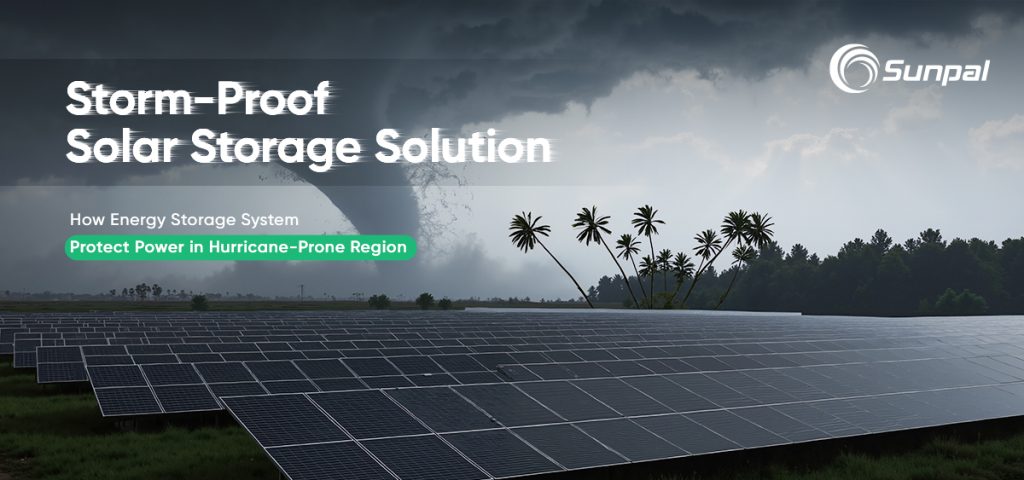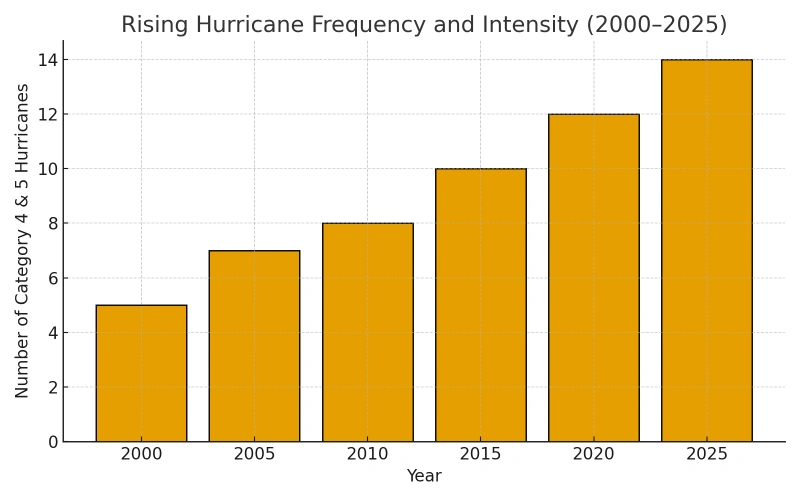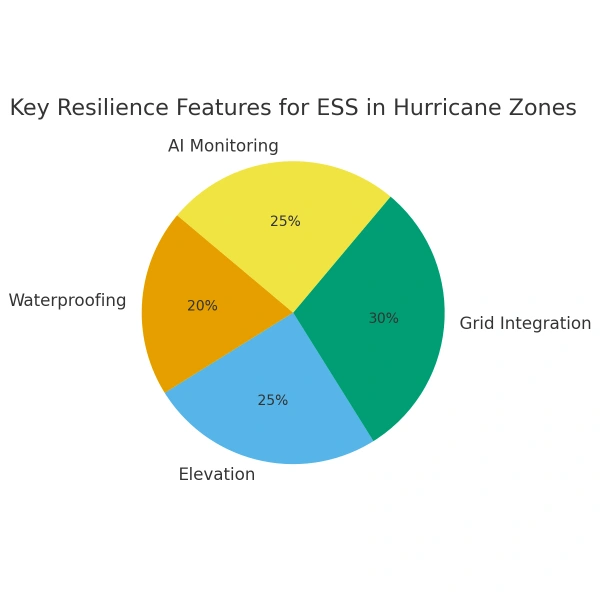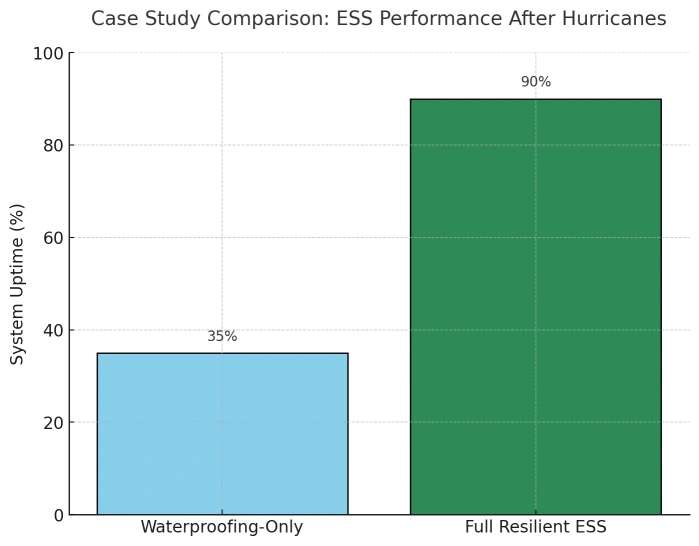
Introduction: Building Resilient Solar Energy Storage
As hurricanes grow stronger and more frequent, energy security is becoming one of the most pressing challenges in coastal and island communities. While waterproof battery storage has been the standard response to protect solar energy systems, storm resilience requires much more. Flooding, high winds, saltwater exposure, and long-term blackouts all threaten the reliability of energy infrastructure.
For businesses and households relying on solar-plus-storage systems, the difference between a waterproof-only solution and a fully resilient energy storage system (ESS) can mean hours versus weeks without power. This article explores how Sunpal Energy sees the future of storage in hurricane-prone regions—beyond waterproofing.
The Growing Hurricane Challenge
Extreme weather events are no longer rare. Global climate studies show that the number of Category 4 and 5 hurricanes has steadily increased, pushing communities to rethink energy resilience strategies.
- Storm intensity: Major hurricanes now reach landfall with higher wind speeds and cause longer outages.
- Economic cost: In the U.S. alone, hurricanes caused over $1 trillion in damages between 2000–2022.
- Energy gaps: Grid restoration can take weeks, leaving hospitals, telecom, and essential services vulnerable.
Chart 1: Rising Hurricane Frequency and Intensity (2000–2025)
This upward trend highlights why solar companies, utilities, and governments are investing in storm-hardened ESS solutions.

Beyond Waterproofing: Redefining Energy Resilience
Waterproofing helps protect batteries from rain and floods, but true resilience demands a broader approach that addresses structural, thermal, and digital challenges.
1. Structural Protection
- ESS must be installed on elevated platforms to prevent flood damage.
- Wind-resistant enclosures should withstand 150+ mph gusts, especially in coastal areas.
- Modular containerized systems offer rapid deployment and protection.
2. Grid Independence with Smart Inverters
- Grid-forming inverters allow ESS to power communities even when the grid collapses.
- Solar-plus-storage can act as a microgrid, maintaining hospitals, emergency shelters, and communication towers.
- This reduces reliance on diesel generators, which often fail due to fuel shortages post-storm.
3. Thermal & Ventilation Systems
- High heat and humidity after hurricanes create dangerous conditions for batteries.
- Advanced thermal management extends battery lifespan and prevents fire risks.
4. AI-Powered Monitoring
- Real-time monitoring predicts failures before they occur.
- Remote diagnostics allow operators to optimize performance even when on-site access is blocked by floods or debris.
Chart 2: Key Resilience Features for ESS in Hurricane Zones
This shows how waterproofing is only part of the solution—grid integration, elevation, and monitoring contribute significantly to overall resilience.

Global Lessons: Failures and Successes
Real-world case studies provide clear lessons on what works—and what doesn't—in hurricane zones:
- Caribbean (2017, Hurricane Maria): Microgrids with solar battery storage restored schools and clinics within hours. Communities relying solely on diesel struggled for weeks.
- U.S. Gulf Coast: Some sites installed waterproof-only ESS, but systems failed due to saltwater corrosion and overheating.
- Southeast Asia: Elevated ESS containers with modular designs operated through severe flooding, showing how physical structure saves millions in recovery costs.
Chart 3: Case Study Comparison – ESS Performance After Hurricanes
Waterproofing alone offered just 35% uptime, while full resilient ESS achieved up to 90% uptime post-hurricane.

Regulation, Safety Standards, and Incentives
ESS designed for hurricane resilience must also meet compliance and safety benchmarks.
- UL 9540A: Ensures fire safety for lithium battery systems.
- NFPA 855: Provides installation guidelines for ESS in buildings and outdoor sites.
- Local building codes: Increasingly mandate wind and flood protection.
Beyond safety, governments are also rewarding resilience:
- Insurance benefits: Certified resilient ESS lowers risk, reducing insurance costs.
- Financial incentives: Many regions now subsidize solar-plus-storage to enhance disaster readiness.
- Corporate ESG goals: Businesses gain reputational advantages by investing in renewable, disaster-proof infrastructure.
Sunpal Energy's Approach to Resilient Storage
At Sunpal Energy, we believe resilience is more than a feature—it is a necessity. Our energy storage portfolio integrates the following:
- Hybrid Inverter Technology: Enables seamless switching between grid, solar, and generator input.
- Modular & Scalable ESS: Adaptable for homes, businesses, and utility-scale applications.
- Smart Energy Management Systems: AI-driven tools for predictive analytics, fault detection, and system optimization.
- Microgrid-Ready Architecture: Provides communities with independent power when the grid goes down.
By combining solar storage systems with advanced resilience features, Sunpal ensures customers have continuous power during hurricanes, typhoons, and floods.
FAQ: Energy Storage in Hurricane-Prone Regions
Q1: Why is waterproofing alone not enough for ESS?
Waterproofing protects against rain and shallow flooding, but hurricanes bring extreme winds, saltwater corrosion, and long outages. True resilience requires elevated platforms, strong enclosures, and intelligent system design.
Q2: Can solar-plus-storage really replace diesel generators after hurricanes?
Yes. Modern solar-plus-storage microgrids can run critical facilities such as hospitals, schools, and telecom centers without relying on fuel deliveries, which are often delayed after storms.
Q3: What certifications should I look for in resilient ESS?
Look for UL 9540A (battery fire safety), NFPA 855 (installation standards), and compliance with local building codes for wind and flood protection.
Q4: How long can resilient ESS provide backup power?
This depends on system size. A properly designed ESS can power critical loads for several days, especially when paired with solar panels that recharge the system during daylight.
Q5: Why should businesses invest in resilient storage now?
Storm-ready ESS lowers insurance costs, reduces downtime, supports ESG goals, and ensures customer trust in regions where hurricanes and floods are frequent.
Why Beyond Waterproofing Matters for Solar Companies
For solar developers, EPC contractors, and utility operators, adopting resilient ESS is not just about protecting hardware—it's about:
- Business continuity: Keeping operations running during disasters.
- Customer trust: Offering reliable, climate-ready energy solutions.
- Competitive edge: Meeting growing demand for storm-proof solar solutions in vulnerable regions.
The solar industry must evolve from basic waterproofing to a holistic resilience mindset, ensuring renewable energy delivers security in times of crisis.
Conclusion: The Future of Hurricane-Ready ESS
As climate change drives stronger and more destructive storms, the future of solar energy storage in hurricane-prone regions is clear:
- Waterproofing is necessary but not sufficient.
- Structural, thermal, and digital resilience are equally critical.
- Smart, integrated ESS solutions ensure communities remain powered through the storm and recovery period.
Sunpal Energy remains committed to leading this transformation, delivering sustainable, storm-resilient ESS that protect homes, businesses, and essential services worldwide.
Ready to learn more? Contact Sunpal Energy today to explore our full range of solar-plus-storage solutions designed for extreme weather resilience.
